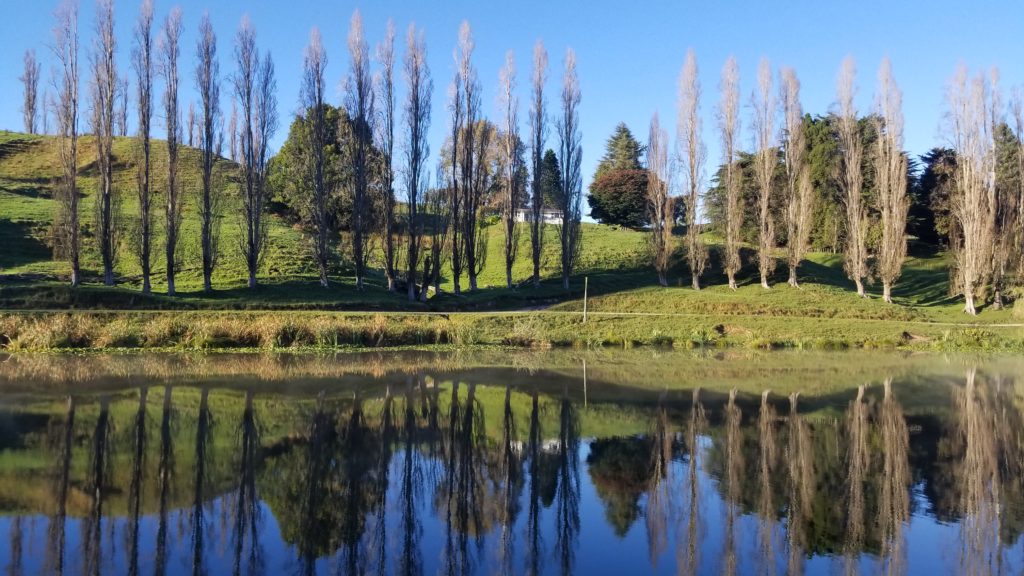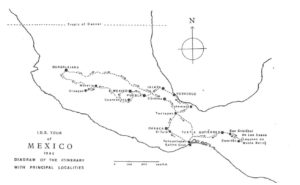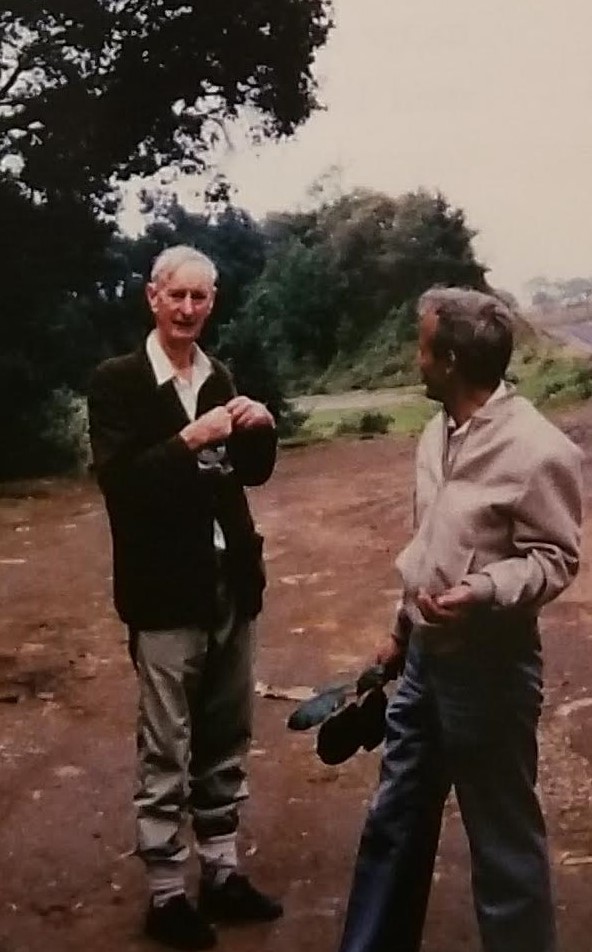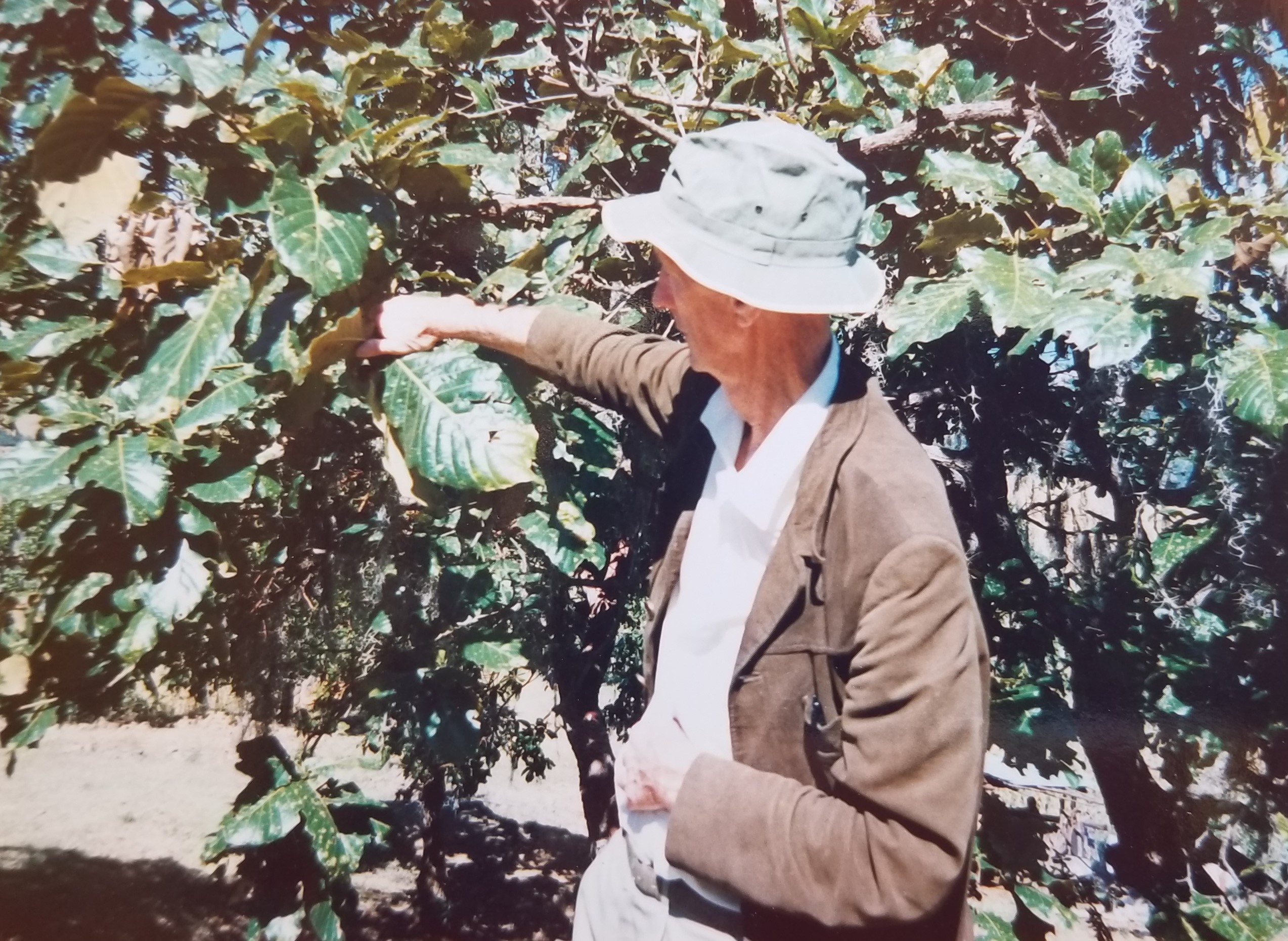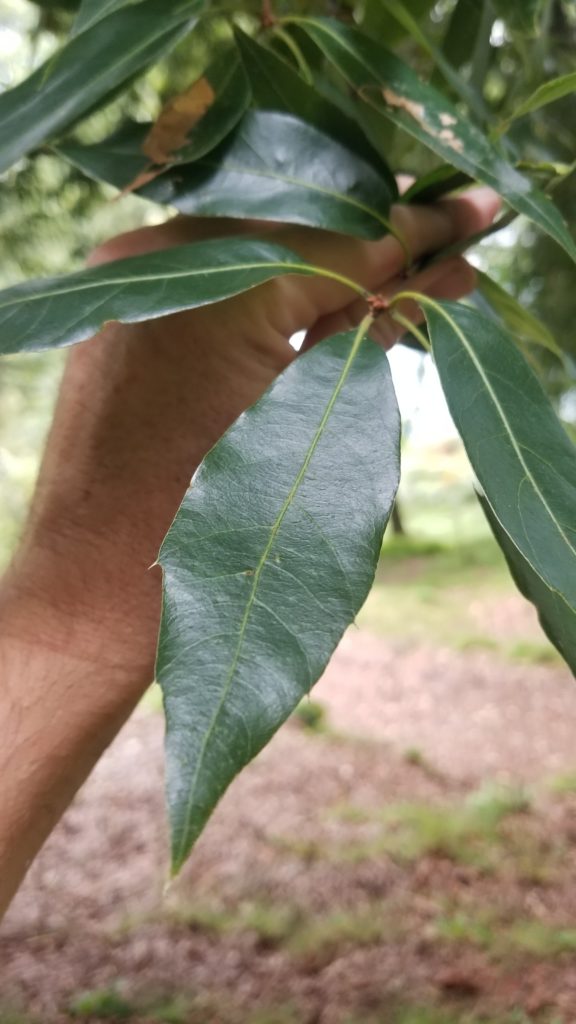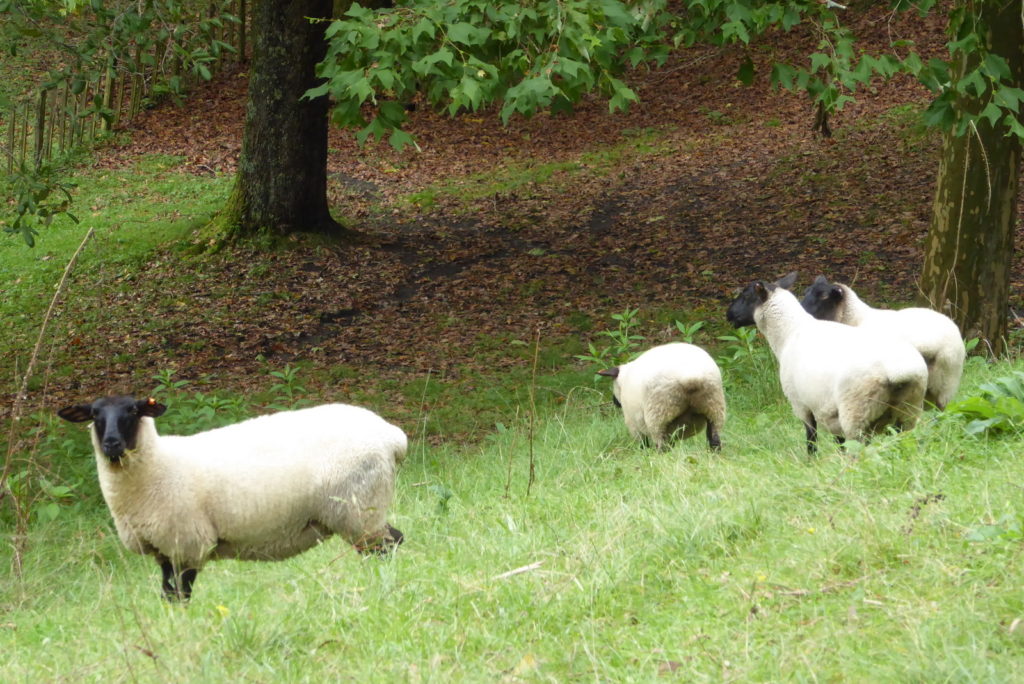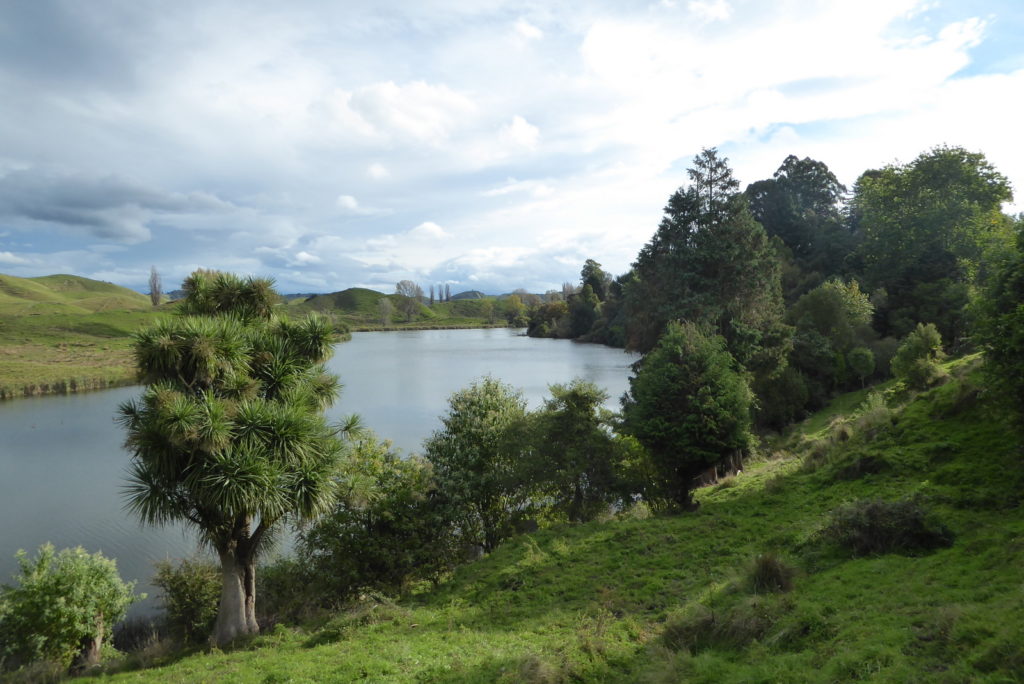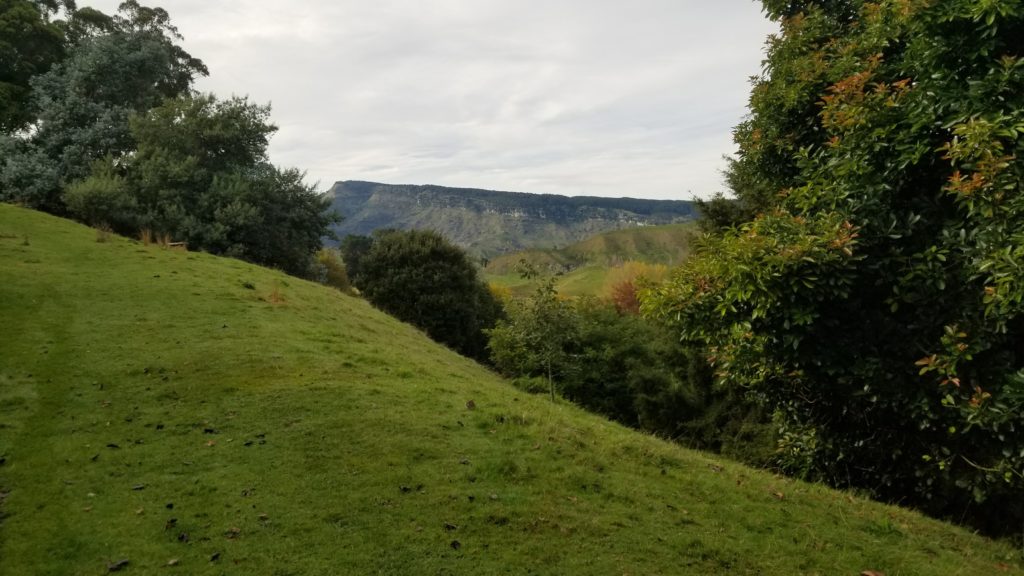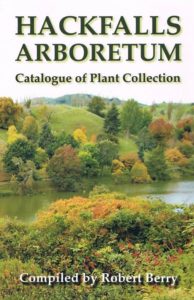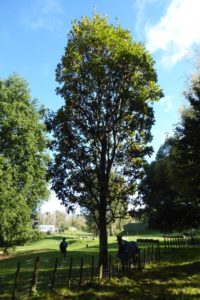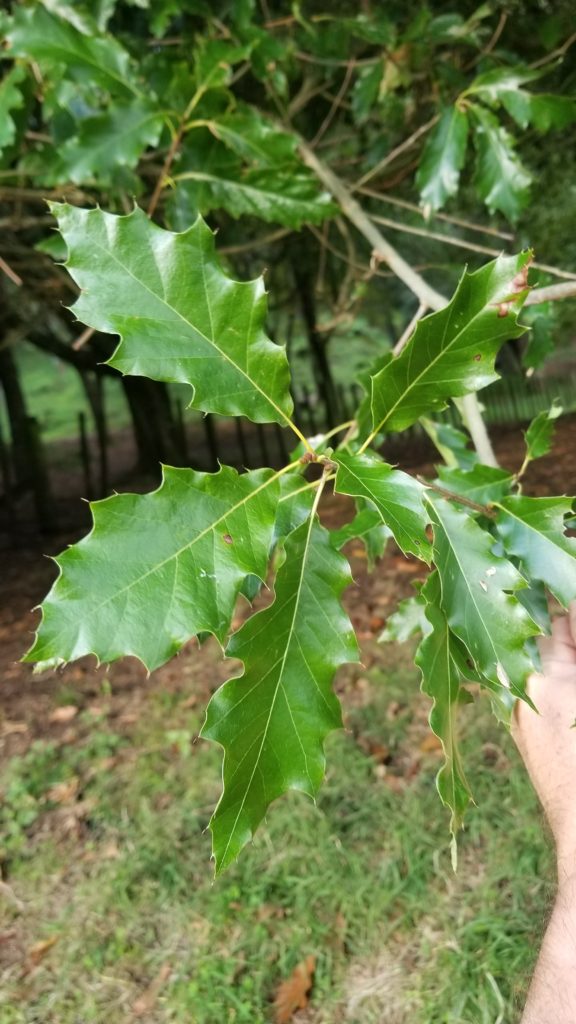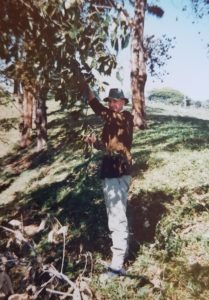Bob Berry: Portrait of an Oak Collector
A reduced version of this article, focusing on Quercus, was published in the Journal of the International Oak Society, International Oaks No. 31, in May 2020.
“Beauty is truth, truth beauty,—that is all
Ye know on earth, and all ye need to know.”
John Keats, Ode to a Grecian Urn
Introduction
“That’s Bob, absolutely, I mean look at his face. It just sums up Bob, the expression, everything about him.”
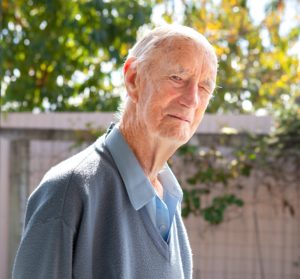
Bob Berry, photographed by Tessa Chrisp www.tessachrisp.co.nz
Michael Hudson is describing a photo of his late friend and fellow plantsman, Bob Berry. I have come to interview him and his wife Carola1, so as to try to understand how a sheep and cattle farmer in New Zealand devoted his late 60s and early 70s to establishing a collection of Mexican oaks, traveling repeatedly halfway across the globe to collect the seed and overcoming innumerable obstacles and frustrations. Surely this was a mild-mannered, tree-hugging enthusiast, seduced by the beauty of trees and their capacity to embellish landscapes. Yet the photo Michael shows me, in a recent magazine article devoted to Bob’s arboretum, depicts a man of dour expression, squinting almost defiantly at the camera lens, his one open eye manifesting a sharpness of gaze that suggests an equally sharp mind behind it. “Bob had a scientific mind,” says Michael, “he didn’t really stand up and love his trees or appreciate them as much as he should have, they were scientifically or botanically of interest to him.”
In the arboretum he created, Bob had planted around 3,700 trees and shrubs representing 161 families, 478 genera, and over 3,500 taxa. The Mexican oaks were the conclusion of his endeavor, like the late works of certain artists that define their oeuvre. Could mere botanical interest fuel such an enterprise? Would I not need to find a deeper fire to explain his ventures? Perhaps an exploration of Bob’s life and work can yield answers to these questions.
Portrait of the artist as a young man
Bob Berry was born in the middle of the World War 1, on Jun 11, 1916, in a place so far removed from the theater of war so as to be in a different season. His family lived on a farm named Hackfalls, near Tiniroto, on the east coast of New Zealand’s North Island, some 60 km west and inland of Gisborne. Bob’s father, James, was a second-generation farmer, whose father had arrived in New Zealand in 1889 from Knaresborough in Yorkshire, UK. Not far from Knaresborough is Hackfall Wood, the origin of the name chosen by Bob’s grandfather for his first farm in New Zealand (it is not clear how the name developed a terminal “s”). Hackfall lies in the valley of the River Ure, near Grewelthorpe in North Yorkshire. It was a tourist attraction in Victorian times, and it was included in one of the scenic routes through the Lake District recommended by Wordsworth.2
James Berry thought he might be called up to fight in the far-off world conflict and in preparation sold the family farm to the Whyte family, Scottish immigrants. James was in fact not conscripted, but Mr. Whyte was not able to pay off his debt to the Berrys and around 1920 in lieu of payment transferred ownership of Abbotsford, another farm.3 Abbotsford, like Hackfalls, was situated in the valley of the Hangaroa River. The original Hackfalls was subsequently divided and in 1984, Abbotsford would be renamed Hackfalls. In 1993, Bob visited the original Hackfall on the River Ure and commented that “the forested valley is rather similar to the valley of the Hangaroa River, especially as it would have been in 1889, before tree clearance.”
Bob grew up on these Hangaroa valley farms and attended primary school at Tiniroto, the local village, till he was 12. After that he was home schooled. He was 14 at the time of the Napier earthquake, centred about 80 km to the southwest of Tiniroto, and the memory of the event would never leave him.4 In his late teens he studied at Massey College (now Massey University), and apparently enjoyed skiing while he was there.3 On reaching adulthood he wanted to be a sailor and join the navy to see the world, but an irregular heart beat put a stop to that, and so like his father and grandfather, he became a farmer: “In my day if you were brought up on a farm, that was your future and you should count yourself lucky, as good alternative jobs were in short supply,” he would write later.5 But his mother and uncle were keen on plants, and they encouraged Bob’s interest in horticulture. Tree planting in particular interested him, but his father saw little point in a tree that did not provide timber or shelter. So he farmed during the week and spent his weekends “planting and tending trees as a hobby.”5
One of the trees that could be safely planted on weekdays was poplar. Traditionally used for windbreaks, on New Zealand farms they are used as living fence posts and to stabilize land. Soil erosion has been a major issue since land clearance began in New Zealand. By the 1930s flooding and soil erosion were a serious concern and the government took steps to reduce their extent. Erosion control material had to be grown in the presence of grazing animals, so trees that could be grown from poles were favoured over seedlings. Poplars and willows were ideal, and in the 1950s a breeding and selection program began that resulted in the release of superior clones.6
Lombardy poplars (Populus nigra ‘Italica’) were introduced in the Tiniroto District by Bobby Sinton, a Scots nurseryman and one of the first permanent settlers in Tiniroto. The oldest poplars at Hackfalls are from that source and are recorded in the catalogue as “many along fences.” They were later used as a source of poles for new fences. In 1946 new species were obtained from Goudie’s Nurseries in Rotorua, including Populus yunnanensis and P. trichocarpa as well as European hybrids. A research center was established in 1968 at Aokautere, near Palmerston North, to centralize the national breeding and selection programs. A further need for greater diversity arose after 1973 when poplar rust (Melampsora larici-populina and M. medusa) reached New Zealand with devastating effect. As new cultivars became available, Bob accessioned and planted them. The catalogue includes 215 accessions, representing 106 taxa and constituting what is probably the most complete collection of the hybrid poplar gene pool in New Zealand.7
The old master
In the year 1950 Bob took over management of the farm, and the number of accessions at Hackfalls spiked significantly. Bob’s father died in 1954 and that must have freed his hand (“It took a few years after he died before I really got going,” Bob would say later.8) Another key event was a visit to a horticulturally minded neighbor. Bob joined the Royal New Zealand Institute of Horticulture, and on one of their field trips in 1953 visited Douglas Cook’s farm at Ngatapa, about 35 km northwest of Gisborne. Cook had bought his farm in 1910 and had begun planting trees and other plants. The First World War had interrupted his project, but after being injured in France, Cook convalesced in English country homes, which would serve as models for his horticultural and dendrological pursuits. He named his farm Eastwoodhill and it would later become New Zealand’s National Arboretum. Plants and seeds arrived from Hillier’s Nurseries in the UK and from Arnold Arboretum in the U.S., among others. This would be the beginning of a fruitful friendship between Bob and Douglas (always “Mr. Berry” and “Mr. Cook” to each other) that further increased accessions at Hackfalls. Bob had initially thought he would focus his collection on maples, and indeed some of the first plants he grew from Eastwoodhill seed were Acer, but Douglas also introduced him to the possibilities of oaks and he was to find that Quercus prospered in Hackfalls’ conditions.9 This marked the beginning of Bob’s oak focus that would culminate in the collecting trips to Mexico 30 years later.
Michael tells me a slightly different version of the story: “There was a meeting at Eastwoodhill when Bob went there I think for the first time, it was something to do more with farming than trees. His father was there, and he was on the farming side the whole time, but Bob suddenly was looking round and seeing these different trees at Eastwoodhill, and that set him off onto the tree side of things quite a bit, going there. And then talking to Douglas I suppose too, but he was always upset that Douglas never actually went to Hackfalls.”
In later years, Bob would make a significant contribution to Eastwoodhill when he compiled a catalogue of the plants there. After Douglas Cook died in 1967, Bob became concerned that labels of Eastwoodhill’s plants were being lost or transposed, and that the value of the collection would suffer. He obtained from an architect a map based on aerial photography overlaid with a grid system. Starting in 1971 he would drive 60 km to Eastwoodhill at least once a week and spend the day exhausting one square of the grid at a time, finding and identifying the plants, many of which were hidden amongst the overgrown ferns. It took him more than a year to complete the process, often having to bring home plant material to try to identify a plant using the books in his library, even studying German in order to use Krüssmann’s Manual of cultivated broad-leaved trees and shrubs.7 When he came to prepare the catalogue, he realized handwritten notes would not suffice, so he bought himself a manual typewriter and taught himself to type, producing the first 39-page, single-space document listing Eastwoodhill’s accessions. His own records of Hackfalls would merit similar efforts, using the same grid system and evolving with time into ever-better formats as modern technology offered more efficient software and geolocation options.
The journeyman years
The late 1950s and the 1960s saw the Hackfalls collection grow steadily, with plants sourced from local nurseries and seed companies, as well as Bob’s own collections in parks and botanical gardens all over New Zealand. The Peter B. Dow Seed Company in Gisborne had a wide variety of species available, some sourced from foreign collections, allowing Bob to receive plant material from the Arnold Arboretum and Royal Botanic Gardens Victoria (RGBV), among others. He also started to request seed directly from foreign gardens and in 1966 travelled to Melbourne to collect personally at RBGV.
In 1977 the International Dendrology Society (IDS) toured New Zealand, visiting Eastwoodhill and Hackfalls (still Abbotsford at the time). It turned out to be a fateful event for Bob. He joined the Society, thus extending his network of seed and plant sources, and would participate in IDS tours that took him to Mexico, Japan and Korea, Northern Ireland, and the Eastern United States. The 1977 tour was organized by Lady Anne Palmer, a renowned horticulturist who created Rosemoor Garden in North Devon, UK. This would be their first meeting, but not their last: thirteen years later Anne and Bob would marry, a “match made in botanical heaven, with Anne’s contributions evident in Hacfkalls’ stunning homestead garden which she extended, introducing a variety of new plants” 10. Of particular importance was the IDS Tour to Japan and Korea in 1980, during which Bob made contact with Carl Ferris Miller, founder of the renowned Chollipo Arboretum on the east coast of South Korea. “Records show just how many new trees seeds were received via this source. This relationship gave access to many species of maple and collections made in Taiwan. Paulownia kawakamii was first introduced into New Zealand from this source along with Photinia davidiana.”9 Accessions listing Chollipo Arboretum ascend to 117 and span two decades, from 1979 to 1998.
But by far the greatest impact the IDS had on the history of Hackfalls was the Tour to Mexico in October-November 1982, which Bob participated in together with his first wife, Amy.11 Initiated at Eastwoodhill, Bob’s focus on oaks was restricted at first to species from Europe, Asia, North Africa, and the United States. Before 1982, his only Mexican oak was a Quercus rugosa planted in 1975, obtained from a group of trees established near McLaren Falls in Tauranga, some 300 km northeast of Hackfalls. The origin of these plants is not certain, but likely to have been grown from seed obtained in Mexico or southwestern USA. The species grew well at Hackfalls, and Bob was keen to obtain other Mexican species, being aware, thanks to studying Trelease’s The American Oaks, of the large diversity of Mexican oak species. As reported in Heino Heine’s account of the Tour, the three-week trip covered:
a vast, strictly tropical but largely mountainous area with one of the richest and most varied and complex woody vegetation in the Northern Hemisphere. It led a party of 16 IDS members to some of the most interesting places of the central and southern part of Mexico, extending from the 21st parallel north to the frontier with Guatemala and to the coasts of both the Atlantic and the Pacific Oceans. Long-needle pines and evergreen oaks as typical representatives from the cooler and higher mountainous regions abound there. They were, from a dendrological point of view, undoubtedly the favourites of any woody plants seen and the very goal of some of the participants.”12
It is tempting to imagine that this last phrase referred to Bob, who later wrote: “[d]uring this tour I managed to do a small amount of acorn collecting, some of these germinated and grew on successfully, a very encouraging result which made me keen to get more.”13 Accessions from this trip were predominantly Quercus and included nine taxa from Hidalgo, Chiapas, Michoacan, and Veracruz. Bob’s keenness “to get more” resulted in six subsequent trips, firstly on his own, and the last two accompanied first by his friend Peter Murphy and then by Lady Anne. The IDS Tour had visited the central states of Mexico, Michoacan, Jalisco, Puebla, and Morelos, and the southern states of Oaxaca and Chiapas. His later trips focused mainly on the central states (1984, 1985, and 1987) and those in 1989 and 1991 also extended further north into the states of Durango and Nuevo León. This reiteration of itineraries may seem unusual, but as Bob explains, “[s]eed production is variable with some species being regular annual croppers while others fruit irregularly, hence the trips in different years.”13 In 1984 he retired from farming and his niece Diane Playle and her husband took over. Just as taking over the farm had released him from patriarchal restrictions on planting, retiring released him to travel and collect.
I ask Michael why Bob chose Mexican oaks. ”He went on that IDS trip, that first time. And saw them there. He wondered whether they’d do better than maples, which don’t do terribly well at Hackfalls. There is not a sufficient demarcation between the seasons and maples want a clear autumn, winter, spring. And up there, there is a marvelous climate, but there is no distinct difference between the seasons.”
The Mexican period
The IDS Tour would have provided Bob with a useful introduction to the practicalities of travelling and collecting in Mexico. It included a 1,500-km, two-day trek from Guadalajara to San Cristóbal de las Casas, with no stops or observations, a “very long and strenuous journey”12, necessitated by a flight cancellation. In future journeys Bob would avoided this risk, travelling by hired taxi with a trusted driver, but evidently he would cover similar or longer distances than in 1982. He collected oaks “from road sides where oaks were in second growth after earlier clearances”9 and also in some gardens, such as Francisco Javier Clavijero Botanic Garden in Xalapa, Veracruz.
An account by Peter Murphy, his companion on the 1989 trip, gives us an indication of what these trips were like:
On our first morning in Mexico, Bob contacted Jesús at the nearby taxi stand, which was only a few minutes’ walk from where we were staying. Jesús had already gone home on the previous night when Bob had tried to call him. When I inquired if Bob had contacted him, he told me that he did not think Jesús would have a phone and as he could not read, Bob had not written to him. Jesús [. . .] had driven Bob all around Mexico on his last trip there [. . .]
In order to collect acorns we had to know where the oak trees grew. Bob had made a study of this and with the help of Jesús we did pretty well. It meant getting off the beaten track into areas frequented by bandits and opium smugglers who travelled throughout some of these areas. We were given the tip-off one day and we made a hasty exit.
Bob had found Quercus insignis on his last visit, but it was not bearing acorns. This time he and our driver could not agree on its location and after a bit of an argument, Bob got his way and the tree was found, this time with a large crop of acorns which were each the size of a bantam egg.
Each night after a day in the field, the acorns had to be closely examined for bugs or disease, packaged and labelled. Bob was most particular and he traced around the edges of the leaves and made notes. We came to Mexico to collect acorns and we did just that.
The language used was Spanish and Bob spoke a smattering of it, but in Jesús we had a good interpreter who also spoke good English [. . .] We bought back a total of 800 acorns, all carefully checked under a magnifying glass to ensure they were bug-free.14
Bob’s smattering of Spanish seems to have been sufficient for him to be able use botanical publications in that language. In a note on his Mexican oak collection written in 2001, he provided a brief bibliography of the books he used to seek and identify oaks on his collecting trips:
- The American Oaks, William Trelease, 1924
- The Central American Species of Quercus, Cornelius H. Muller, 1942
- Flora Novo-Galiciana, Volume 2, Part 1, Number 3, Rogers McVaugh, 1974
- Contribución al Conocimiento del Genero Quercus (Fagaceae) en el Estado de Jalisco, Luz Maria González Villarreal, 1986
- Los Encinos (Quercus) del Estado de Michoacan, Miguel Ángel Bello González and Jean-Noel Labat, 1987
- Identificación de Encinos de México, Fernando Zavala Chávez, 1989
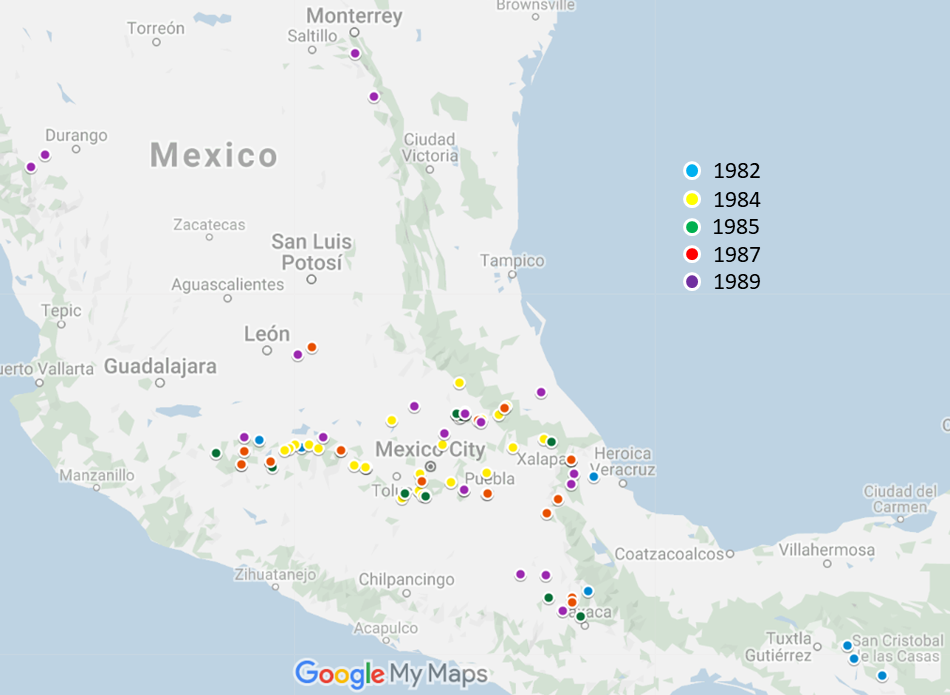
Each dot marks the approximate location of where an existing oak accession was collected, colour-coded for each trip. Most collections are in Central Mexico, with a few further south in the 1982 IDS Tour, and further north in the 1989 trip. Bob also travelled to Mexico in 1986 and 1991, but there are no oaks at Hackfalls collected on those trips (see below).
I ask Michael how Bob acquired his botanical knowledge. ”He just had the bug, that he wanted to do it. And he had a number of books on the oaks, devoured them thoroughly, absolutely.” The story of a man who becomes obsessed with books and then ventures into the world convinced that the world will reflect what he has read in his books . . . It rings a bell. Of course, Don Quixote. I glance back at the photo of Bob in the magazine article and picture an upturned barber’s basin photoshopped onto his head as a helmet. The image fits, somehow. Meanwhile Carola adds some more colour to the description of Bob’s collecting trips, reciting from memory an email she received from Anne about her trip to Mexico in 1991, where she bravely took on driving duties: “’You’ve just got no idea, there we were, stuck in this ghastly cactus desert, day after day. ‘What do you say, Bob?’ Must be some oaks somewhere, but this is ghastly! Bob said, ‘That way!’, and we just went across this desert.” I’m fully expecting her to describe an encounter with windmills next . . .
In an interview in 2018, Bob summarized what he was able to do in Mexico: “There was a window of opportunity and I managed to grab it. When air travel became affordable, you’d do a quick trip, hire a driver or a car. You’d go whizzing round the place and come back again. In a few days you could do what these other fellas, just the generation before, took months to do.”8 One assumes “these other fellas” would have included the likes of William Trelease and C.H. Muller.
In some cases, Bob would identify an oak as a taxon that had been subsequently reduced to synonym status, but he’d stick to his guns and claim that what he had collected matched an original description or the location where the holotype had been found. For example, Q. ocoteifolia, originally described by Liebmann and listed in Trelease, was placed in Q. laurina Bonpl. by the World Checklist and Bibliography of Fagales (Govaerts and Frodin 1998), with no differentiation. Yet Bob in 1985 Bob had found a tree answering to Trelease’s description. The resulting specimens in Hackfalls grew true to type, although the nominal form of Q. laurina also grows in the area within cross-pollination distance. Furthermore, seedlings raised from acorns from the Hackfalls specimen also showed signs of being true to type, despite Q. laurina flowering nearby. Bob noted that “typical leaves are three or more lobed at the broad end, but some specimens have narrower toothless leaves.”13 Trelease’s description of Q. ocoteifolia states “Leaves [. . .] entire or exceptionally with several prominent serratures,” whereas Q. laurina’s leaves are “entire or exceptionally with one or two aristate teeth on each side.”15 Similarly, Q. affinis f. subintegra (A.DC.) Trel. was named by Trelease based on Hartweg’s specimen 422, collected in Zacualtipan. It has, according to Trelease, “more broadly lanceolate, longer-attenuate, commonly entire leaves.”15 Govaerts and Frodin, however, placed it in Q. affinis Scheidw., with no differentiation. But Bob had also been to Zacultipan and begged to differ: “In 1984 I collected acorns of this form in the same area. From this collection I have two specimens which also answer to Trelease’s description of f. subintegra. Second generation seedlings are showing the same leaf details which are different than those of Q. affinis specimens raised from seed collected further south.”16 His identifications are retained in his catalogue.
“He’d be pretty sharp, you wouldn’t pull any wool over Bob’s eyes, ever, he’d be sharp as anything.”
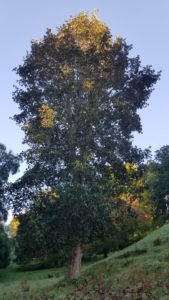
Quercus crassifolia catches the first rays of the sun on the north bank of Lake Kairoike. It was grown from seed collected in 1984 in Morelia, Michoacan, Mexico.
A note in the introduction to an early version of his catalogue explains Bob’s views on the topic:
The naming of Mexican oaks seems to be in a continual state of flux. Some widespread species are very variable, others are not. Also hybridism is more rife than earlier botanists realised. New species are named occasionally, some of which may turn out to be hybrids. Many of those originally named as species are now regarded as either part of one of the widespread variable species or as hybrids. The variations are not separated as subspecies, varieties or forms. Different authorities accept names that others discard, but they are attempting to work toward some sort of consensus. Probably they won’t make it. My view is that at least the terms “variety” or “form” would help to identify more easily which variations were referred to [. . .] This also would in many instances refer to plants with restricted ranges in the wild, which in turn would give a better idea on the growing conditions they would require. As things are at present, the same name can be given to trees which grow on mountains in central Mexico, to ones which grow in the more tropical south.17
Dealing with les douaniers…
Bob obtained import permits before leaving New Zealand and returned with Mexican health certificates, but in order to be able get seed back into New Zealand, he had to declare it at Auckland Airport on arrival, where it would be treated. “We’d have a little expedition and come back with all these seeds. But then they got in a bit of a panic. Because they were biosecurity, not botanists. They didn’t know what was safe and what wasn’t. Acorns are harmless, but you couldn’t tell them that.”8 The acorns would be fumigated, a process from which they did not always emerge unscathed. “The reason for so many trips was that some oak species do not seed every year and some seed lots did not germinate. On one occasion there were none and on another only one seedling. Whether this may have been due to some variation in the treatment the seed were given on arrival in NZ or due to weevil grubs is anyone’s guess” 18. The 1989 trip was in fact a rerun of a previous one which had failed to bear fruit due to the treatment acorns received on arrival: “Bob was making a second trip to Mexico to collect acorns after customs destroyed every one he brought back from his first trip. When they were fumigating the acorns they were overheated. The only compensation he got was a free permit for another trip to Mexico.”14 There are no accessions from Mexico for 1986 or 1988 and only one from 1983. This would fill the gaps between the years where Mexican accessions are listed, implying trips to Mexico every year but one from 1982 till 1989, with a final trip in 1991 with Lady Anne. There are no oak accessions from that last trip, though there are other plants, including Pinus culminicola from San Luis Potosí in Nuevo León. Perhaps whatever acorns were found did not survive treatment?
Michael recounts one of these frustrating experiences. “Not a single thing had germinated or was coming up. He said it’s the way they did them. There was one chap there, he brought stuff in, and the fellow said ‘I won’t be too long, I’ll fumigate them.’ And he went off with his girlfriend for a couple of hours or so, came back and had forgotten all about them but had obviously killed them. Not the slightest interest in them, and so Bob was furious about that. Straight away went over, stayed in the same place, got the same taxi driver, and retraced his steps, collecting.”
After fumigation, seed would have to germinate under quarantine, and Bob dedicated a section of the homestead for this purpose (it is now the swimming pool). The quarantine process was supervised by New Zealand’s Ministry of Agriculture and Forestry, and Bob would be charged for the staff’s time whenever they came to check the seedlings, from the moment they left the office until they got back.14
The window of opportunity was eventually slammed shut, and it became impossible to import any seed. Bob attended the 1997 International Oak Society Conference in California (he had joined in 1996), traveling with Gary Clapperton, then Curator of Eastwoodhill. Guy Sternberg, former IOS President, recalls that the New Zealanders bought a large container of Captan fungicide and treated everything they collected, hoping to persuade customs officers in Auckland that the seeds were safe to import. They were unsuccessful and all acorns were confiscated and destroyed (Guy Sternberg, pers. comm.). While the window was closing, Bob may have been mischievous on occasion: “A friend told me later that it was a good idea to give them a big bunch right at the start, but keep a few in your pocket just in case,” he told an interviewer in 2018. Asked whether he ever outwitted customs officers in this way, he did his best to avoid self-incrimination: “[T]here’s a soft chortle disguised as a cough”, wrote the interviewer. “And then just the barest trace of a smile.”8
The canvas
Hackfalls Arboretum is situated a 177° 30’ E and 38° 47’ S, the latitude would be equivalent in the Northern Hemisphere to San Francisco, Washington DC, Lisbon, or Northern Japan. Altitude is around 270 m above sea level. A landslide about 7,000 years ago, from north and east, created the hilly topography and lakes that characterize the area (Tiniroto means “many lakes” in Maori). Two lakes are the main feature of the landscape at the Arboretum: Lake Karangata (10 ha) to the south and Lake Kaikiore (5 ha) to the north. The soil consists of basal mudstone (known in New Zealand by the Maori term “papa”) and a series of volcanic ash (pumice) deposits, about 50 cm thick. These ash deposits originated from volcanic eruptions in the Taupo-Rotorua region to the west of Hackfalls. (The soil type may have created propitious conditions for Mexican oaks, which would be accustomed to growing on volcanic soils in their native habitat.) Old lake and swamp deposits also contributed to some areas of the soil, and combinations and accumulations of these various soil types are found in places as a result of downwash and slumping. Average annual rainfall is 1,650 mm, and light snowfalls (25 mm deep) usually occur every winter (up to five), though some years are snow free. The highest recorded snowfall was 450 mm in 1988, and it did considerable damage to the trees. Ground frosts of a few degrees Celsius occur every winter. Little is left of the original forest, due to recurrent fires following Maori occupation of the district. Most of the remaining forest was cleared with European settlement, commencing in the 1880s, but a few scattered remnants persist. The largest of these at Hackfalls consists of 4 ha of forest to the north of Lake Kaikiore, now protected together with the arboretum area by a Queen Elizabeth II National Trust covenant.18
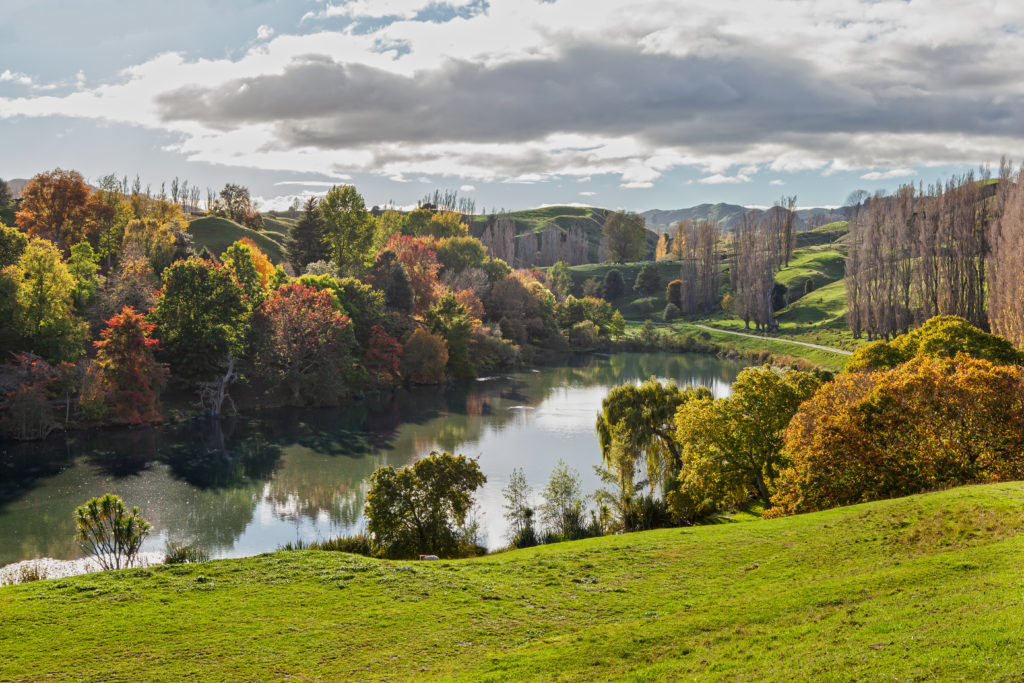
Lake Kaikiore in autumn (photo by Tessa Chrisp www.tessachrisp.co.nz)
One of the lessons Bob learned at Eastwoodhill was the importance of proper spacing. In striving to collect and plant as many specimens as possible, Douglas Cook ended up planting trees too close together, and obstructing attractive views that graced the landscape. Bob initially planted on the north side of Lake Kaikiore forming a backdrop for the view across the lake from the homestead (stunning in autumn, see photo above). The land rises steeply behind the lake and later plantings extended up the gullies there. Other plantings were set in the area to the south of the homestead and then on the higher land between the two lakes and latterly among a network of small valleys along the shore of Lake Karangata.
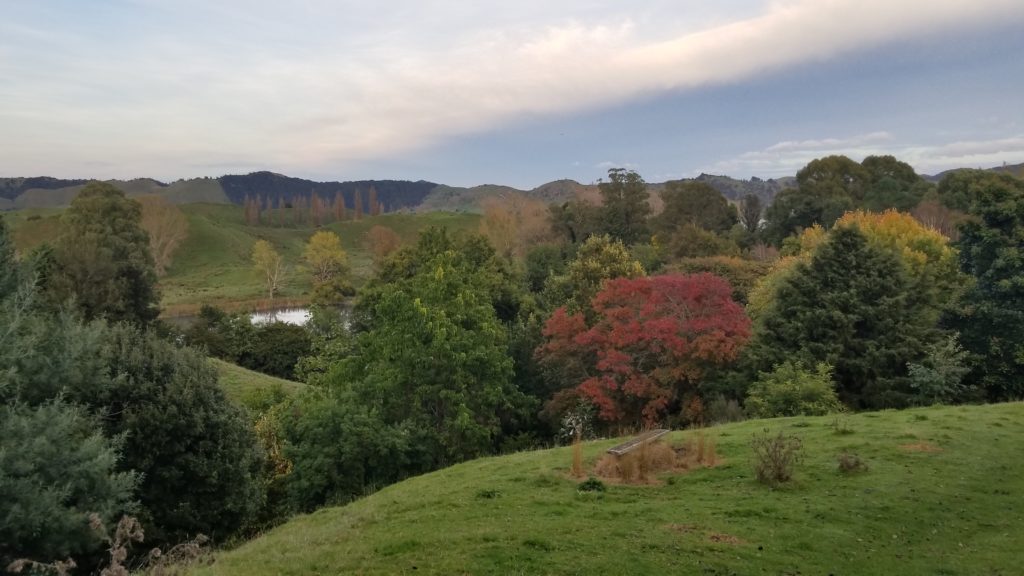
View from the ridge that runs between the two lakes at Hackfalls, with Lake Karangata visible in the middle distance
I am walking through Hackfalls Arboretum, between the lakes, a few yards downhill and south from the top of the ridge that divides them, surrounded by large oaks whose canopies have met. They create a woodland atmosphere where the ground is littered with leaves and grass is crowded out. Cool, shaded, and hushed. I pace out the distance between the trees: 12 paces, 13, 14 . . . I try to imagine the place 30 years previously, where Bob, in his 70s, would have been planting out these trees at what must have seemed planetary distances from each other, sheep grazing among them. Could he have dreamed he would live to see their canopies join?
Ever the practical farmer, Bob used a simple planting strategy: the arboretum was not fenced off and trees were protected with a cage around them at first and widely placed so that the stock could continue to graze (the sheep also served as lawn mowers). Seedlings were planted out as small plants. “Bob reasoned that tap roots could develop early as seedlings in nature did, needing no watering.”9
With oaks he would sometimes even plant acorns directly in their definitive place, with appropriate protection, so as to avoid transplanting altogether.19 His Mexican oaks would be lined out in the quarantine patch, where they would be wrenched (underground pruning with a sharp spade) after one year, then lifted out into 15-liter kerosene tins, later to be planted out as seedlings.20 Maintenance was minimal, aside from some structural pruning: “My trees are mainly grown at wide spacing and while some grow with a good central stem, others are heavily branched from near the base. If possible I prune to get a single clear stem to 2-3 m and remove double headers.”13
“He was fairly rough with his plants. He gave us a couple of oaks once, one of them was quite a good one. I wouldn’t have dared doing what he did to the one he gave me, myself, but that was partly because of his climate there was far better than ours here for getting things started or growing initially, and you could be rough with them and get away with it. The practicalities of what the plant would have wanted, did not come into it as it might have sometimes.”
The catalogues
Detailed documentation is key to the value of any botanical collection, a notion that Bob understood from the outset. He maintained meticulous records, starting with a handwritten list in 1963. The same application he devoted to cataloguing Eastwoodhill he of course also dedicated to his own collection, and in 1972, having progressed to typing for the Eastwoodhill project, he produced the first type-written records for Hackfalls. It was followed by a succession of word-processor-generated catalogues starting in 1993.9
Bob recorded source details for each accession, whether it was the name of a local donor or nursery, or the place where seed was collected by a roadside in Mexico. The precise location of a specimen in the arboretum was also noted in the catalogue, at first using a grid system where a letter and number identified a square in the grid, and two further numbers indicated the distance north and east in meters from the southwest corner of the grid. In later editions, GPS coordinates were recorded for most specimens. When the catalogue moved from the typewriter to a computer, photographs were incorporated, with many plants illustrated with several images: of the full tree, bark, leaves, flowers, and—especially for the oaks—a twig with leaves and a 10-cm scale bar, in some cases with acorns. In many cases, height and trunk diameter measurements were also recorded.
Bob identified his own wild collections, but for the Mexican oaks in 2004 he invited Allen Coombes, at the time botanist at Sir Harold Hillier Gardens, to spend a season at Hackfalls and review his identifications. Allen commented at the time, “I was impressed by the range of species Bob was growing there and by the size and growth rate of the trees. Just considering the oaks, this is a collection of international significance and many of those I have found I have not seen better plants of in gardens since. Bob had the insight to start collecting the Mexican oaks long before most. Many of his plants are now represented as specimens in the Harold Hillier Herbarium.” A number of Bob’s original identifications were modified, though in some cases Bob retained a name (“left on hold at present”) or recorded a difference of opinion, always based on specific observations and research. Recollecting his time at Hackfalls, Allen wrote recently: “I remember Bob’s amazing energy in walking around the garden and of course the seemingly endless collection, some of which I had only seen in cultivation as small and often struggling plants, and some never. And those that liked the warm humid conditions were growing so fast.”21
The Hackfalls Catalogue was published in 2011 as 3CDs containing files in Word format. “This is one of the most complete and detailed listing of any collection that I have seen published and it is very useful, not only in documenting the collection but for those that are unable to visit, a chance to see the splendour that is Hackfalls,” wrote Allen Coombes about this publication. “It should also serve as a guide to what other collections could be doing [. . .] I have no criticisms of this publication, even of the names used, because I know that Bob has put as much energy and passion into identifying his plants as he did in collecting and planting them.” 22
In 2016, with help from friends Pat and Nick Seymour, Bob published the catalogue as a 400-page hardcover book: “Hackfalls Arboretum: Catalogue of Plant Collection.” It was also made available on the Arboretum’s website. It included over 900 photos, mostly taken by Bob, with some photos of Mexican oaks by John von Pein. These were taken in 2003 at the request of Antoine le Hardÿ de Beaulieu and Michel Timacheff for the renowned Guide Illustré des Chênes23, and a few were included in the printed book, as were some of Bob’s photos of oaks in his collection. Bob had also migrated the list of plants to Excel format, and recently work has been done to publish the catalogue online as a searchable database that incorporates the images from the printed catalogue as well as more recent photographs (http://hackfalls.org.nz/tree-collection-catalogue/).
The oak collection at Hackfalls
The oak collection evolved gradually and would have been a respectable quercetum by global standards, a paler reflection of Eastwoodhill, were it not for the impressive wild-sourced Mexican oaks accessioned during the 1980s. These oaks are what makes Hackfalls extraordinary.
The first oak planted on the property was a Quercus robur, planted by Bob’s mother in 1935. Acorns collected in Windsor Great Park were distributed by the New Zealand Women’s Institute to mark the Jubilee of King George V. It has been rumored that there was not enough seed to go round, and the batch was augmented by acorns from Hagley Park in Christchurch, so the origin of the Hackfalls tree is uncertain.24 For fifteen years it was the only oak on the property, while the paternal edict forbade non-functional plantings. The first oak species to make an appearance once the ban was lifted was Q. palustris, first from a local nursery in 1951 and three years later form Eastwoodhill. During the rest of the 50s and the early 60s a handful of common species from Europe and the U.S. were acquired from nurseries and seed collected at Christchurch Botanical Garden. Starting in 1961, more taxa entered the collection via seed obtained through Dow Seeds of Gisborne, collected in Melbourne BG, including Q. calliprinos. In 1962 Bob was able to collect seed in Australian gardens himself, obtaining seed from Q. glauca and more unusual U.S. oaks, such as Q. ×leana. Seedlings imported from Hillier’s Nursery started to enter the collection in 1964, including Asian Q. aliena and Q. myrsinifolia, as well as Q. chrysolepis and Q. douglasii form California. Noteworthy is a chance Q. macranthera seedling form Hillier’s Nurseries that has adopted a fastigiate habit despite being raised from acorns of the normal spreading form (see photo above). Rarer taxa accessioned in the late 60s include Q. pontica and Q. ×schochiana. Seed from the Arnold Arboretum first arrived in 1969, adding Asian species (e.g. Q. serrata, Q. mongolica) and U.S. hybrids (Q. ×humidicola). During the 70s new taxa were accessioned from Eastwoodhill, presumably as specimens there reached maturity and fruited, amongst them the renowned Q. ×ludoviciana (St Landry oak), and an unusual hybrid, deemed to be Q. afares × ×hispanica25 ‘Ambroziana’. Q. pagoda and Q. shumardii were obtained as seed from the U.S. Forest Service form Mississippi. During this decade the first trees grown from seed harvested at Hackfalls were accessioned, starting with Q. arkansana, from a tree imported from Hillier’s that later died above the graft.
The first Mexican oak was accessioned from within New Zealand in 1975 (Q. rugosa), then from 1982 through 1990 the vast majority of oak accessions were those collected by Bob on his collecting trips (click here to download a table detailing Accessions of Mexican Oaks at Hackfalls). In 1993 some rarer Asian species begin to be recorded from an anonymous source, recorded simply as “private” in the catalogue, with no other details provided. Species include Q. bambusifolia, Q. oxyodon, Q. annulata, Q. lamellosa, Q. stewardiana, and Q. saravanensis (amongst others). However, the private source responsible for the majority of these Asian accessions has indicated that identification may be doubtful: Bob was too quick in assigning a name, especially to a young plant with no flower or fruit, and he later regretted having done this as it has created confusion.26 Some of the most recent accessions are of particular interest: putative hybrids from seed collected at Hackfalls, some involving species that are not sympatric in nature. They include a group of hybrids collected from what Bob had identified as Q. candicans var. calophylla (now Q. calophylla), which he suspected were sundry crosses with Q. shumardii, Q. palustris (see photo), Q. imbricaria, and Q. ocoteifolia.
The oak collection consists of 451 accessions. They include 6 taxa from Asia Minor, 28 from Asia (some tentatively identified as yet), 31 from Europe, and 42 from the U.S. The 182 accessions from Mexico represent 39 species, 2 varieties, 3 hybrids, and 27 unconfirmed identifications. Location in the arboretum is not based on geographical origin, but rather seems to follow the order of accessions, generally radiating outwards from the homestead as the arboretum grew to accommodate more trees. Quercus is the second most represented genus in the arboretum, behind Rhododendron (currently 454 taxa); other key genera include Acer (100 taxa approx.), Alnus (40), Betula, (40), Eucalyptus (50), Ilex (40), Magnolia (70), Malus (40), Populus (100), Prunus (70), Salix (60), and Sorbus (60).
Recognition
Recognition for Bob’s work and his arboretum began in 1989 when he was awarded the North Island Forester Award by the New Zealand Farm Forestry Association, and the well-deserved accolades and medals continued in a steady stream in the following years—Associate of Honour of the Royal New Zealand Institute of Horticulture (1991), Life membership of the NZ Farm Forestry Association (2002), Hackfalls Arboretum designated a “Collection Distinguished for Merit” by the IDS (2002), Eastwoodhill Centennial Award (2010), Ronald Flook Award from the New Zealand Arboricultural Association (2011), Lifetime Service Award from the International Oak Society (2012)—culminating in 2015 with the Veitch Memorial Gold Medal awarded by the Royal Horticultural Society for “outstanding contributions to the advancement of the science of horticulture.” Only seven New Zealanders had previously received the medal. In addition to cataloguing Eastwoodhill’s plants and thus contributing to its preservation and eventual designation as the National Arboretum of New Zealand, Bob shared many of his Mexican oak collections with Eastwoodhill. They are planted in a section of the collection known as Mexico Way. The path leading to it is named “Bob Berry Walk” in recognition for his services to the Arboretum.
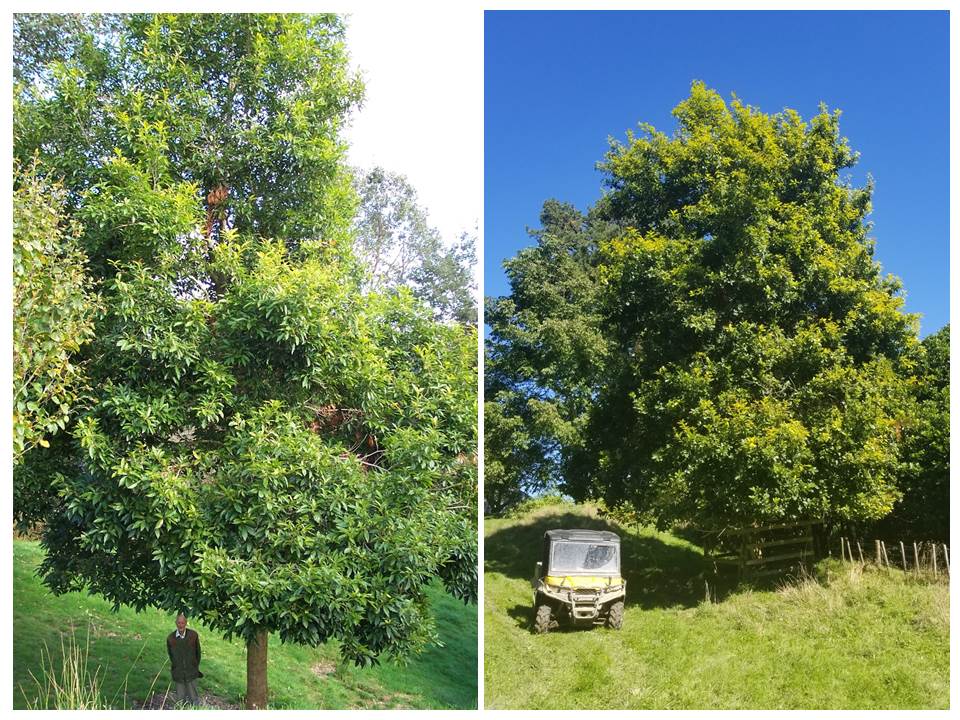
Quercus insignis at Hackfalls (left with Bob Berry, 2004) and Panikau (right, 2019), both trees grown from seed collected by Bob and Peter Murphy in 1989 near Huatusco, Veracruz
But Bob’s legacy spreads far beyond Eastwoodhill. He shared with other collectors seedlings grown from acorns he collected in Mexico13 and later allowed nurseries such as Appleton’s of Wakefield, NZ, to collect acorns and propagate and distribute oaks. This activity continues at present. Seedlings of his Mexican oaks are growing in collections around New Zealand, and in arboreta such as the Guthrie Smith Arboretum in Tutira, NZ. One of the oaks Bob was proudest of, Q. insignis, collected in 1989 near Huatusco, Veracruz, with Peter Murphy, was planted in both Hackfalls and Peter’s renowned garden Panikau, where it has prospered and grown as large or larger than at Hackfalls (see photo above). The Hackfalls specimen recently produced seed27 and a seedling has been propagated at Eastwoodhill, where it awaits plantation. Some of the legacy is even serendipitous: a tree planted at Massey University in Palmerston North, NZ, was found as a volunteer in the pot of another tree acquired at a nursery which had collected seed at Hackfalls. It has since been determined to be Q. sartorii, a rare Mexican oak, which could only have come from an acorn that dropped off Bob’s tree. 28
The future
Hackfalls is currently cared for and maintained by Bob’s niece, Diane Playle, who at the same time manages the farm, a more-than-full-time job. The Hackfalls Charitable Trust was formed in 1993 to generate funds for future maintenance of the Arboretum. Paid local labor and volunteers contribute to the considerable work involved in keeping the collection in good order: an Arbor Camp held each year on a long weekend in autumn, during which arborists from all over New Zealand and the world try out new equipment, exchange skills and information, and contribute to tree maintenance. Other volunteers include a Dutch couple, Dick Bos and Wilma Verburg, who spent five summers at Hackfalls working on maintenance (and writing up their experience in an extensive blog: https://hackfalls.wordpress.com/), and Peter Marshall and Colin Samundsett, who travel regularly from Australia to work on specific arboricultural tasks and updating labels and catalogue records. Work is also being done propagating rare accessions: “With the assistance of a grant from the New Zealand section of the [International Dendrology] Society plans are in place to propagate a number of the rarer species represented by only one or two accessions. This will be done by applying an aerial layering technique and partnering with Eastwoodhill Arboretum to grow on and establish duplicate collections.”9 Allan Jellyman, one of the few other New Zealanders to receive the Veitch Memorial Medal, wrote in 2016: “The importance of this collection as a gene pool of trees that could enrich New Zealand landscapes and provide new options for rural land management is, regrettably, not yet fully appreciated. It is the writer’s view that the Hackfalls Arboretum is of national importance and assistance is required from influential agencies in the country to ensure that resources are made available for the good of our national landscapes.”9
Ecce homo
I set out in this article to discover what could have motivated Bob Berry to create his arboretum and in particular his world-quality collection of Mexican oaks. I have learnt he was not a particularly diligent plantsman: he was “rough with plants” and perhaps did not give them what they wanted. He did not have a special bond with trees: “I don’t even hug trees [. . .] I leave mysticism to others.”29 When posing for photographs with his trees, Bob stood next to them, a few yards apart; he didn’t lean one hand on the trunk or gaze up at its canopy in admiration or fondness. The attitude seems to be ecce homo, ecce arbor: here I stand, and here stands a tree; I put it here, but now it towers above me and has a life of its own.
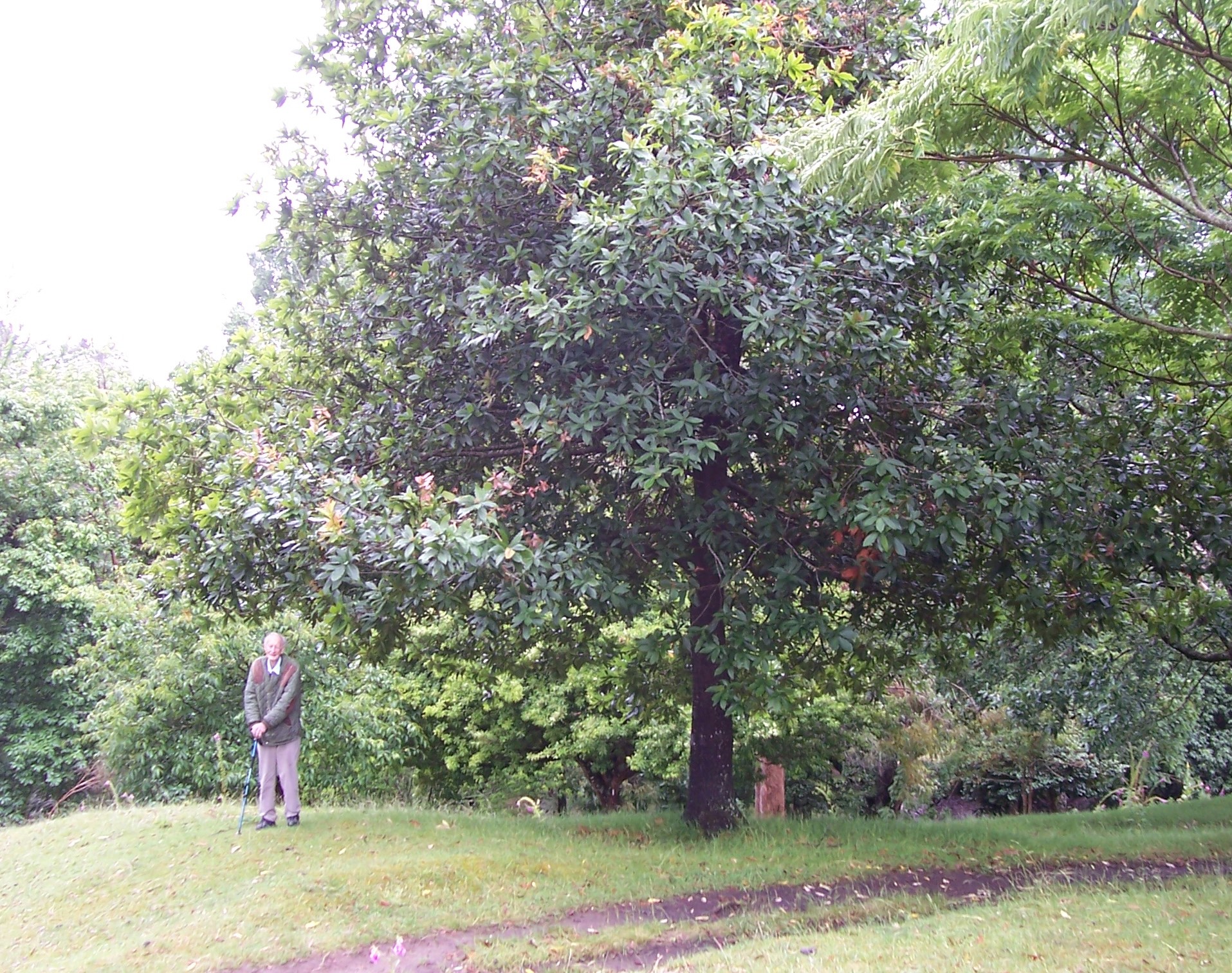
Ecce homo, ecce arbor: Bob Berry with Quercus rysophylla, grown from seed collected in 1989 near Chipinque, Nuevo León. Photo taken in 2015 by Jay Sorenson.
I recall that his grandfather named his farm—cleared of the little vegetation humans and fires had left, dedicated to the rearing of livestock—after a landscaped woodland admired by Romantic poets. Could there be a destiny in a name? Could such a destiny have driven the immigrant’s grandson to beautify his farm, sacrificing precious grazing space? The name was so powerful that it was transposed to the new property, where it seemed to have found the place it was destined to name (the “fall” in Hackfall is thought to derive from a word meaning valley, and the current Hackfalls has indeed two valleys, where the two lakes sit, posthumously justifying the final “s” added to the original name). More likely, a “green gene”, latent in previous generations, but sufficiently present to influence a choice of name, was eventually manifested in Bob.
If this is the case, the gene evidently skipped a generation, and perhaps Bob’s interest was fueled into passion through paternal opposition: “My father said he didn’t mind me planting a tree, so long as it was useful. For him, a tree was timber. He wouldn’t have approved of what I’ve done [. . .] But he would have been astonished at the fact that the farm is now known worldwide.”8 Anyone who has sat at dawn by the lakeshore at Hackfalls, admiring the backdrop of autumnal foliage through the faint mist rising form the water, listening to the song of the tui (Prosthemadera novaeseelandiae) and grey-warblers (Gerygone igata), as I had the privilege of doing in April 2019, (click here to hear it for yourself), could not but imagine that the park had been created by an aesthete, a landscape artist in the tradition of the creators of Hackfall in North Yorkshire. Bob, however, would never have admitted to a passion, or even to a pursuit of beauty, at least not in the conventional sense of the word. In an interview a few weeks prior to his death on August 2, 2018 (his heart may have beaten irregularly, but it did so for 102 years), he was asked about his relationship to his trees:
“I didn’t talk to trees of hug them or any of that sort of thing. I’m strictly scientific.”
“But you love them?”
“Science! Science! I’m interested in the botanical side of things. For most people in New Zealand, the idea of growing a tree is just thinking of the timber, or its value as a shelter belt or something. I’m interested in the tree botanically. I couldn’t give two hoots about the wood.”
“Surely you see their beauty?”
“Well hang on. You mean . . . to look at? Or to be interesting? They’re two different things. The priority is different.”8
So I have found no clear answers to the question as to what motivated this remarkable, modest man of quixotic features, this tall, lean farmer from Tiniroto. But I suspect that for him “science” was the name he gave to beauty and “interest” was the term he allowed himself to use to refer to passion. Perhaps that is all we need to know.
Acknowledgments
I would like to thank Peter Marshall, who drove and guided me during my visit to New Zealand in 2019, providing information and contacts; Michael and Carola Hudson for receiving us at Gwavas and sharing their insights; Michael and Cushla Murphy for receiving us at Panikau and providing access to Peter Murphy’s book, Peter Nikau; Diane Playle for hospitality at Hackfalls and answering my numerous questions; and to the following for assisting with research: Caroline Boisset, Allen Coombes, Margaret Long, Elizabeth Malcolm , Guy Sternberg, and Martin Wilkie.
References
Beaulieu, Antoine le Hardÿ de, and Thierry Lamant. Guide Illustré Des Chênes. Paris: Éditions du 8ème, 2006.
Berry, R. 2001. “Mexican Oaks at Hackfalls Arboretum.“ Unpublished manuscript, January 2001.
Berry, R. 2008. “A Few Reminiscences of a Tree Planter.” The Gardener’s Journal. Published by Margaret Long, Christchurch. Issue 1, (Feb 2008) pp. 23-24.
Berry, R. 2011. Hackfalls Arboretum. Word documents on 3 CDs. Supplied by Touchwood Books, Hastings.
Berry, R. 2016. Hackfalls Arboretum, Catalogue of Plant Collection. Privately published.
Cameron, R. 2017. First Time Ex-Situ Reproduction of Quercus insignis. https://www.internationaloaksociety.org/content/first-time-ex-situ-reproduction-quercus-insignis. Accessed 2019 12 27.
Cameron, R. 2019. Rare Mexican Oak Pops Up in Palmerston North. https://www.internationaloaksociety.org/content/rare-mexican-oak-pops-palmerston-north. Accessed 2019 12 17.
Chassé, B. 2011. “In the Spotlight: Robert James Berry from Tiniroto, North Island, New Zealand.” Oak News & Notes, Vol. 15, No. 1, p. 4.
Govaerts, R. and D.G. Frodin. 1998. World checklist and Bibliography of Fagales. Royal Botanic Gardens, Kew.
“Green Acres.” 2013. Gisborne Herald, Nov 2, 2013. Retrieved from https://dickbos.wordpress.com/2013/12/. Accessed 2019 02 27.
Heine, H. 1982. Tour of Mexico. International Dendrology Society Yearbook, 1982: 45–51.
“History.” n.d. NZ Poplar & Willow Trust, www.poplarandwillow.org.nz/about/history. Accessed 2019 02 27.
Jellyman, A. 2014. Profile of a horticulturist: Bob Berry, creator of Hackfalls Arboretum. New Zealand Garden Journal, 2014, Vol. 17(1): 5–9.
Jellyman, A. 2016. Hackfalls Arboretum. International Dendrology Society Yearbook, 2016: 181–188.
Malcouronne, P. 2018. The Man Who Planted Acorns. NZ Gardener. September 2018: 55–61.
Murphy, P. 2008. Peter Nikau. Privately published. Te Rau Design and Print, Gisborne.
Trelease, W. 1924. The American Oaks. Memoirs of the National Academy of Science 20:1–255.
Wilkie, M. 2017. Bob and Anne Berry: Great Trees in the Forest. Rhododendron Species (yearbook of Rhododendron Species Botanical Garden) 2017, Vol. 12: 113–136.
Wordsworth, W., and A. Sedgwick. 1842. A Complete Guide to the Lakes: Comprising Minute Directions for the Tourist, with Mr. Wordsworth’s Description of the Scenery of the Country, and Three Letters upon the Geology of the Lake District. London: Hudson and Nicholson.
Footnotes
- I interviewed Michael and Carola Hudson in Gwavas, their estate near Tikokino, Hawke’s Bay. Their woodland garden, restored and developed by Michael since the 1950s, has been recognized by the International Dendrology Society with a “Distinguished for Merit” award.[↩]
- Wordsworth and Sedgwick 1842[↩]
- Diane Playle, pers. comm.[↩][↩]
- Wilkie 2017[↩]
- Berry 2008[↩][↩]
- “History” n.d.[↩]
- Jellyman 2014[↩][↩]
- Malcouronne 2018[↩][↩][↩][↩][↩][↩]
- Jellyman 2016[↩][↩][↩][↩][↩][↩][↩]
- “Green Acres” 2013[↩]
- Amy was a Scottish nurse whom Bob met in Opotiki, a seaside town northwest of Tiniroto. She shared his interest in trees and it was through this shared activity that they met (Diane Playle, pers. comm.).[↩]
- Heine 1982[↩][↩]
- Berry 2001[↩][↩][↩][↩][↩]
- Murphy 2008[↩][↩][↩]
- Trelease 1924[↩][↩]
- Berry 1999[↩]
- Berry 2011[↩]
- Berry 2016[↩][↩]
- Bob Berry, pers. comm.[↩]
- Peter Marshall, pers. comm.[↩]
- Allen Coombes pers. comm.[↩]
- Coombes 2011[↩]
- Beaulieu and Lamant 2006[↩]
- Jellyman 2014, Malcouronne 2018[↩]
- The former name of Q. ×crenata[↩]
- Anonymous, pers. comm.[↩]
- Cameron 2017[↩]
- Cameron 2019[↩]
- Chassé 2011[↩]
